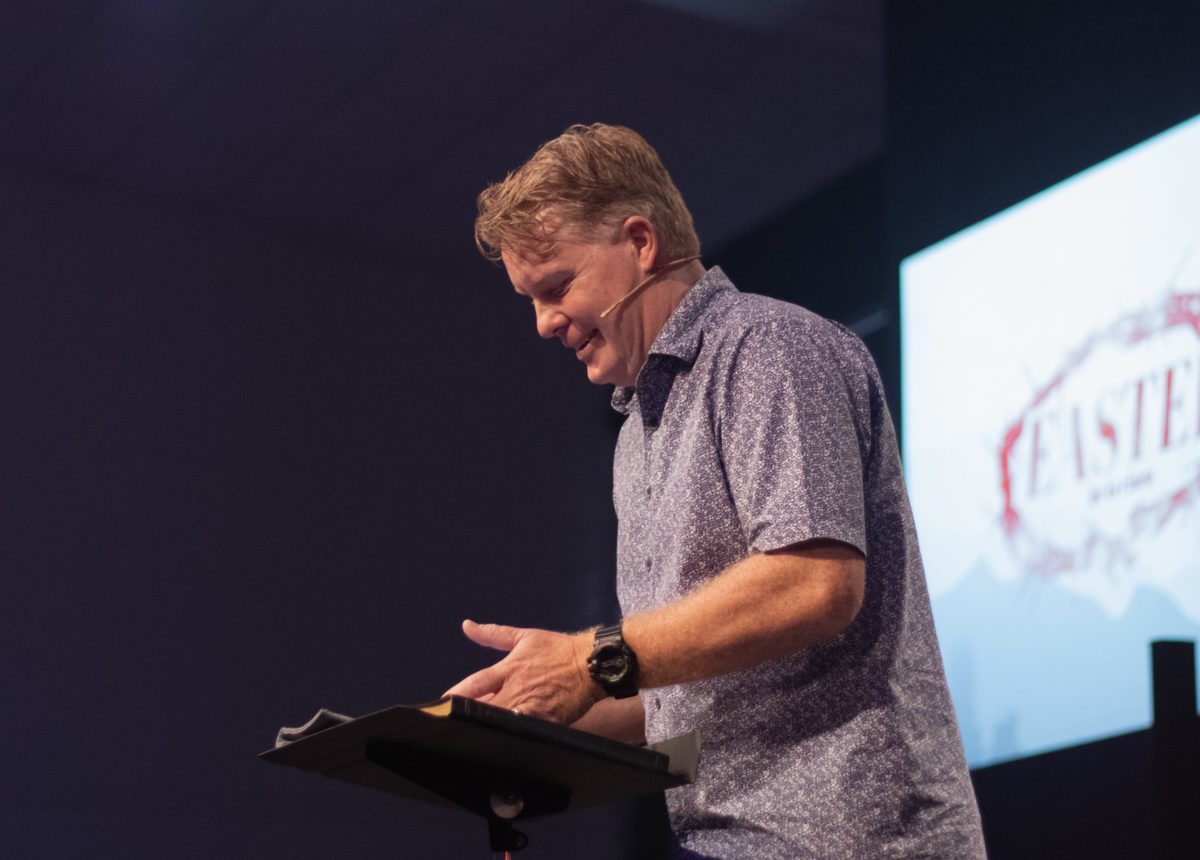Here is an important preaching stat — 68% of pastors spend 6 or more hours planning their weekly sermon. The modern day sermon series has helped to provide a framework for preaching on a central theme of scripture and with the amount of time going into planning each weekly sermon, it is important that the content not be forgotten after the series is over and that is where we must engage visual memory.
It is vital that your sermon series is supported through high impact sermon series graphics.
The oration of the sermon is responsible the verbal part of communication. Sermon series graphics take care of the visual aspect of communication.
To get the most out of your message and receive the greatest return on your investment (hours and hours of study, prayer, planning, and preaching) you want graphics that will allow your key points come alive.
Won’t a simple image search work for my sermon graphics? Possibly — but first, consider the amount of media your congregation will take in every day. Videos, ads, graphics, photos, podcasts, television, cinema.
In terms of visual communication, you are competing with big budgets, top shelf talent, and artistic acumen. You don’t need to ‘beat’ the competition. You simply need to be on a par with the competition with your most important graphics, sermon graphics.
How much media have you taken in today? Videos, ads, graphics, photos, or podcasts?
Now more than ever it is vital that the vision for your sermon series be properly supported through high impact sermon series graphics. And by high impact, we mean visuals that support your message, highlight key points, and drive your message home without distracting or conflicting images.
Can sermon series graphics really do that? You bet!
Expanding the reach of your message into visual communication is a big job and it needs to be done right. Flippantly choosing sermon graphics only adds noise and distracts from your message.
Do Sermon Graphics Really Matter?
As a pastor, you obviously have your heart centered on teaching your congregation and creating disciples. Your calling is to help each one learn and grow in their relationship with God.
You care about those who are on the receiving end of the message God has given you and, at the very least, you want to be used as an inspiring voice that God speaks through.
So, if the message is God-inspired and if the Spirit moves through the text, do sermon graphics really matter?
Yes. Consider selectively choosing graphics to support your message as paying attention to the small details that can have tremendous impact and lasting effect on your listeners. Look at sermon graphics as creating a picture of your church’s mission and each graphic visually represents where God has called you to lead your people.
Why You Should Include Supporting Graphics
Let’s start by looking at the general breakdown of planning your sermon series. We’ll take a look at some practices you may already be following and dive into how sermon series graphics play a crucial role in supporting your message content.
Develop and Solidify An Overall Main Point for the Sermon Series
Long before you get into the details of your content for the sermon series, you’ve likely landed on the sermon series big idea. This is the main point you want your people to remember after they attend one of your services.
Your main point could be as broad a topic as forgiveness, hope, trust, rest, or peace. For simplicity, let’s say you choose rest as your main point. You want to drive home the biblical importance of resting and creating margin in daily living.
With rest chosen as your main point, you’ll have secondary points that will be made throughout the series. Perhaps an example secondary point would be:
- Christians need to prioritize making space for relationships with others in their schedule and create margin in their hearts for a relationship with God.
To support your big idea and series main point, you will have different passages of scripture, unique stories, fill-in-the-blank notes, and other illustrations to point back to the big idea. All of these sermon elements drive home the idea of rest starting with Jesus.
Choose A Main Theme to Support Your Sermon Series
Your main point doesn’t have to be your sermon series theme… in most cases, it should not be. Before you actually choose a theme that will carry out the work of conveying your main point, here are a few things you should have ready.
- You’ve landed your overall main point and takeaway.
- You’ve broken that down into supporting categories.
- You’ve provided a solid week-to-week framework.
- Your framework allows you to break down each topic into individual sermon elements.
- Your sermon elements support the central message of the sermon.
- The central message of the sermon supports the series big idea!
With this information you are in a good position to choose how you want to theme your sermon series.
When choosing your sermon series theme, ask yourself the following questions:
- What tone do I want to set for each week’s sermon? What mood do I want people to take on?
- What feelings do I want to evoke when talking about this upcoming sermon series?
- If I had to describe my personal teaching “style” for this new series, what words would I use?
- What was the tone of the series just before this one? The one immediately following?
Answering these questions will help define a clear direction for developing your sermon series theme. The theme will then inform your sermon series graphics and the overall ‘look’ of the series.
The sermon series theme look will set the tone, create the mood, help to evoke feelings, match your teaching style, and compliment where you’ve been as a church and where you are going.
Create a Look and Choose a Sermon Series Graphic With Supporting Images
The more time you think through mood, feeling, teaching style, and collaborating with others, the stronger your position will be for creating high-impact sermon series graphics.
In keeping with our example of Rest above, you could take a humorous approach to this series—or you could take a serious tone. Your answers to the questions on choosing your sermon series theme will inform the design.
Here is an example of a theme:
Finding Rest

This series from High Street Church in Springfield, MO, is about the importance of finding rest as we live day-to-day in a fast-paced and chaotic world.
The artwork does a good job of communicating the busyness of life and the title is clear. It’s very relatable to any audience because most of us can relate to a full schedule and the reality of having to navigate through a variety of decisions and circumstances.
This graphic is a great example of one that provides clear messaging and allows for the content of each individual message to be very flexible.
In the name of creativity, it is easy to over-complicate what should be simple and clear. The majority of the time clear over clever is more beneficial and just letting people know what they can expect provides the straightest path to impact.
Let’s take a look at gathering inspiration for the right sermon series graphics.
Where to Find Inspiration for Sermon Series Graphics
Just doing a web search and looking through images on Google is one way you can pick out your sermon series graphics.
But it’s not the right way.
Let’s say you’re doing an 8-week series, you take 10 hours (on average) to prep each message. That is 80 hours dedicated towards verbally communicating God’s Word.
An 8-minute Google search is a poor stewardship of visually communicating God’s Word.
Inspiration is vital to your sermon and inspiration is just as important for your sermon series graphics.
Here are some thoughts to help trigger inspiration for what the graphic might look like:
- What inspires you to do good?
- Who inspires you and challenges you?
- Are there life situations or circumstances you’ve walked through that influence your choices every day?
- What books or articles have you read on the subject of your series?
Answer the questions and you will start to get a vision for what connects everything together — this vision is the inspiration for your graphic.
What Story Do You Want Your Sermon Series Graphics to Tell?
Doing the work of developing a main point and identifying sources of inspiration naturally leads to thinking about the overall story arc you want to use for your sermon series.
It’s time to decide on a graphic that will tell the story you’re creating.
| Finding the right angle for your sermon series is important before you start pulling from personal inspiration because you will discover many different ways to tell the same story. Knowing your angle will help you discern how to allow inspiration to drive you. |
If you’ve landed your angle, great – your angle should be evident throughout your teaching content. Your angle should inform your visuals as well. In addition to your angle, your own personal preferences are important as well.
If you, the pastor, do not connect with the sermon series graphic, it will be hard for you to connect the graphic with the series. It is vital that you see the design as a compliment and that you resonate with the artistic interpretation.
Consider the Audience and Who You’re Trying to Reach With Your Teaching Series
Finally, consider if your audience will be able to make the connection between your message and your sermon series graphics. Your sermon series graphic and individual sermon graphics should help you reinforce your message — not steal away from it.
Is this series evangelical in nature, meant to attract seekers from outside the church? Consider excluding “churchy” language and visuals that are not familiar to those who are unfamiliar with faith faith.
Keep in mind that this is not about eliminating everyone else who falls outside of your target audience. Identifying your target audience allows you to be much more effective in your approach to those you are trying to reach.
Conclusion: Series Graphics Done Right Will Help Your Sermons Make a Bigger Impact
The idea of creating or even choosing a creative design or sermon series graphic that will support your message may feel daunting or outside the scope of your gifting. Or maybe it’s less about your gifting and more about where you want to spend your time and focus your energy, which is likely primarily on writing and developing your teaching content.
Remember, your sermon series is a reflection of your church. It’s an important tool that God has given you to further His message using your voice. Using graphics and series branded visual elements to support your content is a powerful tool that will give your teaching a lasting impact and carry it further than words alone.
To learn even more about the impact of sermon series graphics, effectively marketing your sermon series, and to access even more helpful tips and resources on choosing the right graphic for your sermon series, check out the full article, Sermon Series Graphics – The Ultimate Guide For Churches.





